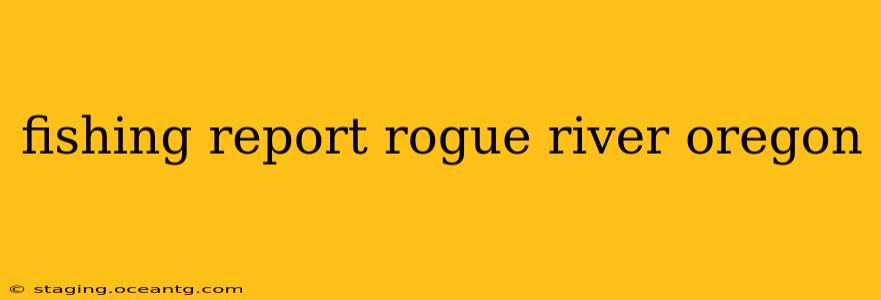The Rogue River in Oregon is a legendary fishery, renowned for its diverse species and stunning scenery. Whether you're an experienced angler or just starting out, understanding current conditions is key to a successful trip. This comprehensive fishing report will provide you with up-to-date information and insights to help you plan your next Rogue River adventure.
What are the current fishing conditions on the Rogue River?
Current fishing conditions on the Rogue River fluctuate greatly depending on the time of year, recent weather patterns, and water levels. To get the most up-to-date information, I recommend checking with local fishing guides, bait shops, or the Oregon Department of Fish and Wildlife (ODFW) website. These resources often provide real-time reports including water temperature, flows, and recent catches. Remember to always check for any fishing regulations or closures before heading out.
What fish can I expect to catch on the Rogue River?
The Rogue River boasts an impressive variety of fish, making it a truly exciting destination for anglers. Expect to find:
- Chinook Salmon: These powerful fish are a prized catch, particularly during their spawning runs. The timing of these runs varies, so checking recent reports is essential.
- Coho Salmon: Another sought-after species, Coho salmon also migrate up the Rogue, providing thrilling fishing opportunities.
- Steelhead: These hard-fighting fish are a staple of the Rogue, offering anglers a challenging and rewarding experience year-round.
- Rainbow Trout: Abundant throughout the river, rainbow trout offer great action for all skill levels. They are a popular target for fly fishing enthusiasts.
- Smallmouth Bass: The Rogue's warmer waters also support a population of smallmouth bass, adding another dimension to the fishing opportunities.
What are the best fishing techniques for the Rogue River?
The best fishing technique depends on the target species and the time of year. Popular methods include:
- Fly Fishing: A favorite among many anglers, fly fishing is particularly effective for trout and steelhead.
- Spin Casting: This versatile method works well for a variety of species, using lures like spinners and spoons.
- Drift Fishing: This technique involves drifting bait or lures downstream, allowing the current to carry them through fish-holding areas.
What is the best time of year to fish the Rogue River?
The best time to fish the Rogue River varies depending on your target species.
- Spring: Steelhead and trout fishing is excellent.
- Summer: Bass fishing and trout fishing are strong.
- Fall: Salmon fishing is the main attraction, with Chinook and Coho runs providing exciting opportunities.
- Winter: While some fishing is still possible, it can be more challenging due to weather conditions.
What are the best fishing spots on the Rogue River?
The Rogue River offers countless fishing hotspots, ranging from accessible stretches to more remote areas requiring a hike. Specific locations are often kept confidential by experienced anglers, but researching public access points and consulting with local guides can help you discover productive fishing spots. Remember to practice Leave No Trace principles and respect private property.
Where can I find more information about fishing regulations and licenses?
The Oregon Department of Fish and Wildlife (ODFW) website is the best resource for accurate and up-to-date information on fishing regulations, licensing requirements, and current fishing reports. Always ensure you have a valid license before fishing and familiarize yourself with the rules and regulations to ensure a responsible and enjoyable fishing experience.
Are there guided fishing trips available on the Rogue River?
Yes, numerous guided fishing trips are available on the Rogue River. These trips offer a great way to learn new techniques, access prime fishing locations, and increase your chances of a successful outing. Searching online for "Rogue River guided fishing trips" will provide many options.
This Rogue River Oregon fishing report provides a general overview. Remember to always supplement this information with current, localized reports to maximize your fishing success. Tight lines!
